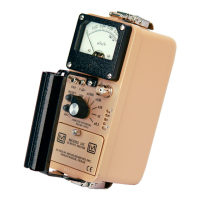Model 14C Survey Meter
Ludlum Measurements, Inc. Page 5 July 2022
If the needle is pointing as indicated below and the range selection switch is on the ×0.1 scale, then
the reading is 0.1 mR/hr.
The same needle indications on successive ranges would be:
×1 = 1.0 mR/hr (or 1000 µR/hr)
×10 = 10 mR/hr (or 10,000 µR/hr)
×100 = 70 mR/hr (or 70,000 µR/hr)
×1000 = 1.0 R/hr (or 1000 mR/hr)
The dial shown below has three arcs: a counts per minute scale (cpm), a linear mR/hr scale, and a
non-linear mR/hr scale for the ×100 range only. The meter face also has a BAT TEST position.
The top cpm scale is valid for the ×0.1, ×1, ×10, and the ×100 ranges. The linear (middle) mR/hr
scale is valid for the ×0.1, ×1, ×10, and ×1000 (using the internal detector only) ranges. The non-
linear mR/hr scale is valid for the ×100 range only. This meter face is commonly referred to as a
“combo” meter face, since it has both count rate (cpm) and exposure rate (mR/hr) arcs. Simpler
meter faces may only have a count rate or an exposure rate arc(s) like the previous meter faces
shown.
A “combo” meter face is specifically designed for a particular detector. In the example above, the
1.0 mR/hr mark on the middle arc lines up with 3.3 kcpm on the upper arc. The meter face in this
example works with a detector that receives 3.3 kcpm per mR/hr (the Ludlum Model 44-9 pancake
detector.) Additional detectors may be used with this meter face, but only the cpm dial is valid for
these detectors. The mR/hr scale is not valid for these additional detectors.

